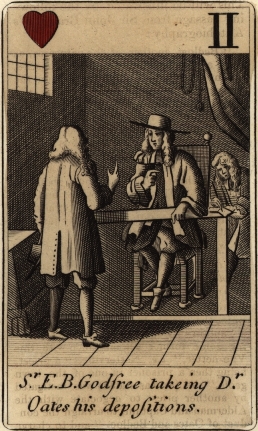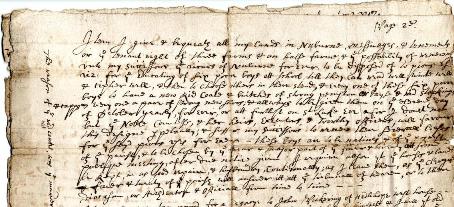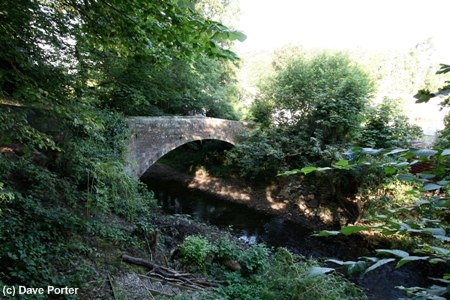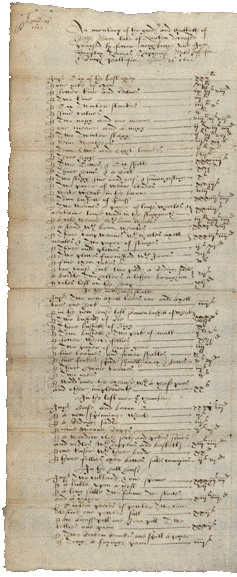Wills and Local History
| Just as the passing generations and shifting fortunes of a particular family can
be traced back through the Durham probate records, so also can the history of a local community. With the North East Inheritance catalogue being available online, it has never been easier to investigate how much has changed in your parish, town or city, and indeed how much has remained the same. While individual wills can bring to light important local incidents and also shed a slanting light on national events, by considering collections of local wills made over a number of years significant trends and pattern can emerge, and which can place that locality in the national picture of the time.

|

Will of Randall Fenwick of Lambton, gentleman. One of the witnesses later made a deposition that on 2 July 1644 Fenwick had returned wounded from the battle on Marston Moor to the house of his master and kinsman Sir William Lambton in Minster Yard, York, 'and ther lay sick for the space of twenty days or therabouts'. Lambton himself, a colonel in the royalist army, was slain in the same action. The royalists' defeat that day was a turning point in the English civil war.
Ref: DPRI/1/1647/F5/1-2. |
| |
 |
Josias Dockwray, the vicar of Newburn, made provision in his will to endow a charity to educate six boys in his parish, to be uniformed in red. 'The reason of the rid coates was the murder of Sir Edmund Godfrey the 12th October, whose Blood which others designed, I would have remembered against the papysts.' The murder of this magistrate was tied to the great Catholic scare instigated in 1678 by Titus Oates, and commemorated in this contemporary playing card, reprinted from The Gentleman's Magazine (1849).
Durham Probate Records DPRI/1/1683/D9/1 |
Social History
Communities together share and transform the landscape over the years. In their wills the individuals who together still colour our own sense of place can speak directly to us. For many of them their last will and testament was the only opportunity they would have had to document their lives and concerns. A number of schools and local charities still active today can be traced back to endowments made in wills, sometimes hundreds of years ago.
Individual buildings and bridges or particularly bad stretches of road can also be rediscovered through probate records. |
![The Will of William Angas of Rawhouse [?Roe House] in Bywell St Peter, yeoman. Click for larger image and transcription. Image of the Will of William Angas of Rawhouse [?Roe House] in Bywell St Peter, yeoman. Ref: DPRI/1/1637/A6/1-2](images/DPRI-1-1637-A6-1_small.jpg) |
A public spirited bequest by William Angas of Rawhouse [?Roe House] in Bywell St Peter, yeoman. This bridge still spans Riding Mill Burn. Rebuilt c. 1603, traces of an earlier structure can be seen particularly on the southern abutment, the very 'casings' Angas' legacy specifies. The bridge, 3' 10" wide, was originally built for packhorses.
Durham Probate Records DPRI/1/1637/A6/1-2 |

Economic History
Probate inventories, with their detailed lists of household goods, work gear and stock can afford a series of snapshots of consumer tastes, agricultural practices, wages and prices, and wider economic trends within the region.
Probate records are primarily concerned with the transmission to the next generation of the deceased's personal property, and as such they present excellent opportunities for the researcher to measure the changing activities and fortunes of particular families, trades and places.

George Mann was a prosperous husbandman from Norton, and his 1622 inventory provides a detailed insight into his husbandry. The inventory lists his livestock - cattle, sheep, hens and geese - and proceeds to his goods in the hall house. The gear includes
seven wains, five ploughs and three harrows. Six oxgangs of land are listed, sown with
winter and ware (spring) corn, highly valued at £57: eight oxgangs was the traditional
measure of land one team of eight oxen could plough in a year, and Mann owned six 'of
the best'. Among the debts of his estate are payments for average grass (a kind of feudal
tenant service), men and women's wages and 12 pence to a 'boy for driving of the plough'.
Ref: DPRI/1/1622/M1/3. |
 |
|
Local and Regional Scope
The North East Inheritance catalogue is designed to facilitate researchers creating study collections of probate records based on their own criteria: one might easily compare the wills of merchants in Newcastle with those in Durham, or analyse the changing lifestyles of labourers and yeomen in a couple of parishes, or perhaps examine the development of the coal trade over the whole region. Names can be collated to uncover otherwise undetected circles of kin and also the debt and credit networks that knit communities and regions together.
Whether you are researching a house, a community or the whole region of the North East, the North East Inheritance catalogue has much to offer you.







![The Will of William Angas of Rawhouse [?Roe House] in Bywell St Peter, yeoman. Click for larger image and transcription. Image of the Will of William Angas of Rawhouse [?Roe House] in Bywell St Peter, yeoman. Ref: DPRI/1/1637/A6/1-2](images/DPRI-1-1637-A6-1_small.jpg)
